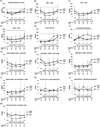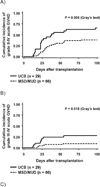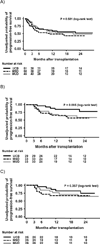Immune recovery in adult patients after myeloablative dual umbilical cord blood, matched sibling, and matched unrelated donor hematopoietic cell transplantation
- PMID: 22698485
- PMCID: PMC3472115
- DOI: 10.1016/j.bbmt.2012.06.005
Immune recovery in adult patients after myeloablative dual umbilical cord blood, matched sibling, and matched unrelated donor hematopoietic cell transplantation
Abstract
Immunologic reconstitution after allogeneic hematopoietic cell transplantation is a critical component of successful outcome. Umbilical cord blood (UCB) transplantation in adult recipients is associated with slow and often inadequate immune recovery. We characterized the kinetics and extent of immune recovery in 95 adult recipients after a dual UCB (n = 29) and matched sibling donor (n = 33) or matched unrelated donor (n = 33) transplantation. All patients were treated with myeloablative conditioning. There were no differences in the immune recovery profile of matched sibling donor and matched unrelated donor recipients. Significantly lower levels of CD3+, CD4+, and CD8+ T cells were observed in UCB recipients until 6 months after transplantation. Lower levels of regulatory T cells persisted until 1 year after transplantation. Thymopoiesis as measured by TCR rearrangement excision circle was comparable among all recipients by 6 months after transplantation. In a subset of patients 1 year after transplantation with similar levels of circulating T cells and TCR rearrangement excision circle, there was no difference in TCR diversity. Compared to HLA-identical matched sibling donor and matched unrelated donor adult hematopoietic cell transplantation recipients, quantitative lymphoid recovery in UCB transplantation recipients is slower in the first 3 months, but these differences disappeared by 6 to 12 months after transplantation.
Copyright © 2012 American Society for Blood and Marrow Transplantation. Published by Elsevier Inc. All rights reserved.
Conflict of interest statement
Figures







References
-
- Seggewiss R, Einsele H. Immune reconstitution after allogeneic transplantation and expanding options for immunomodulation: an update. Blood. 2010;115:3861–3868. - PubMed
-
- Rocha V, Labopin M, Sanz G, et al. Transplants of umbilical-cord blood or bone marrow from unrelated donors in adults with acute leukemia. The New England journal of medicine. 2004;351:2276–2285. - PubMed
-
- Laughlin MJ, Eapen M, Rubinstein P, et al. Outcomes after transplantation of cord blood or bone marrow from unrelated donors in adults with leukemia. The New England journal of medicine. 2004;351:2265–2275. - PubMed
Publication types
MeSH terms
Substances
Grants and funding
LinkOut - more resources
Full Text Sources
Other Literature Sources
Research Materials

